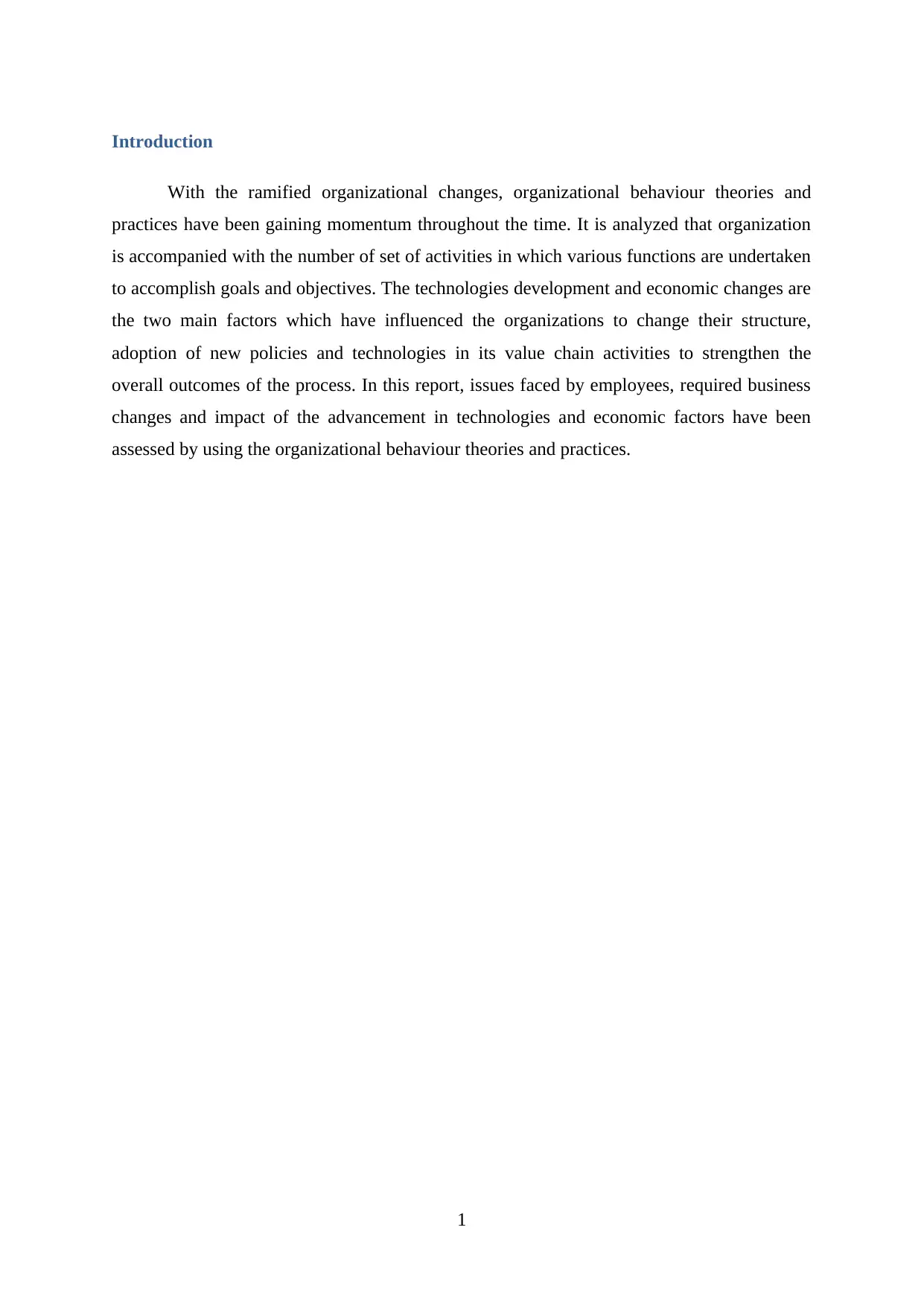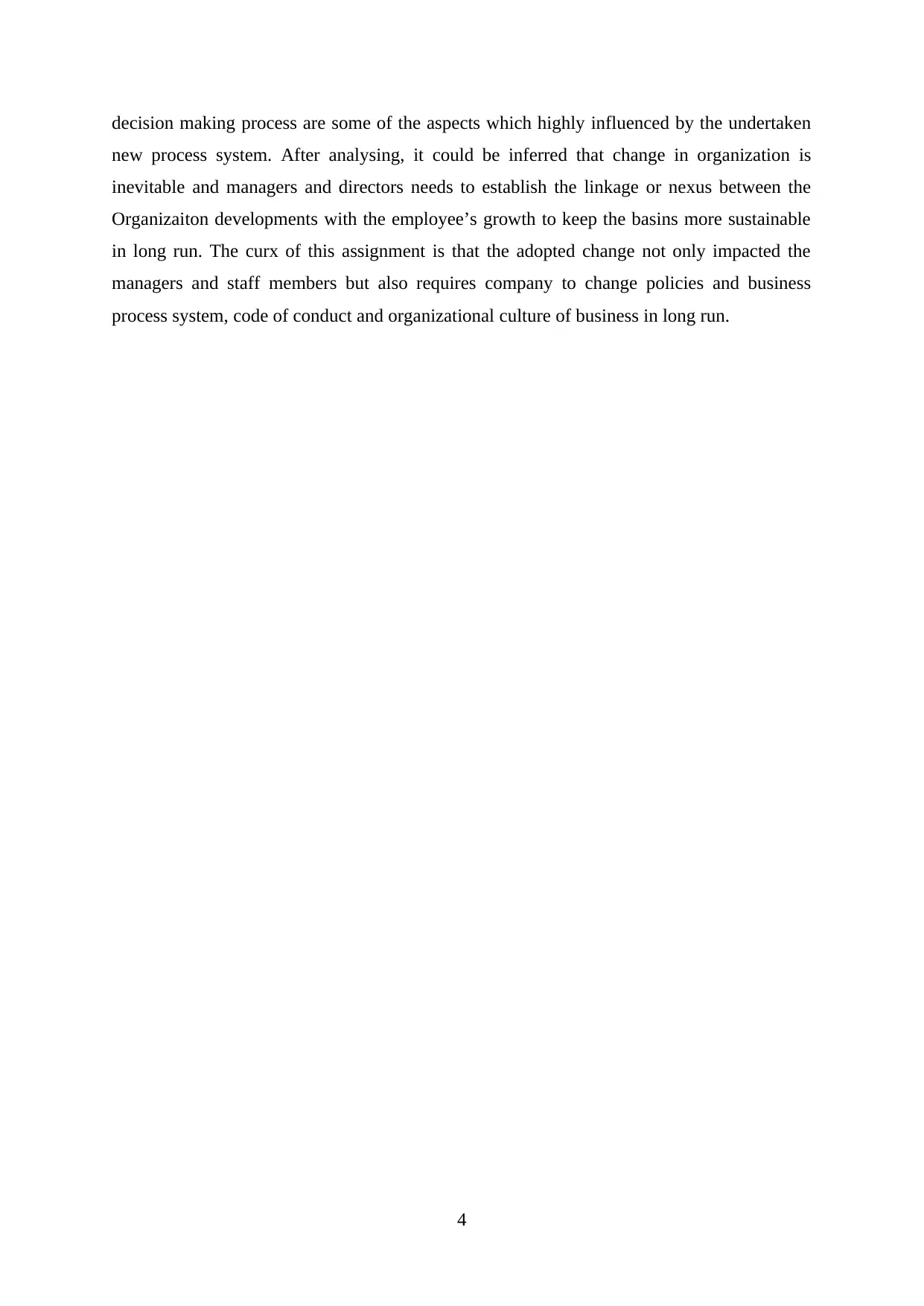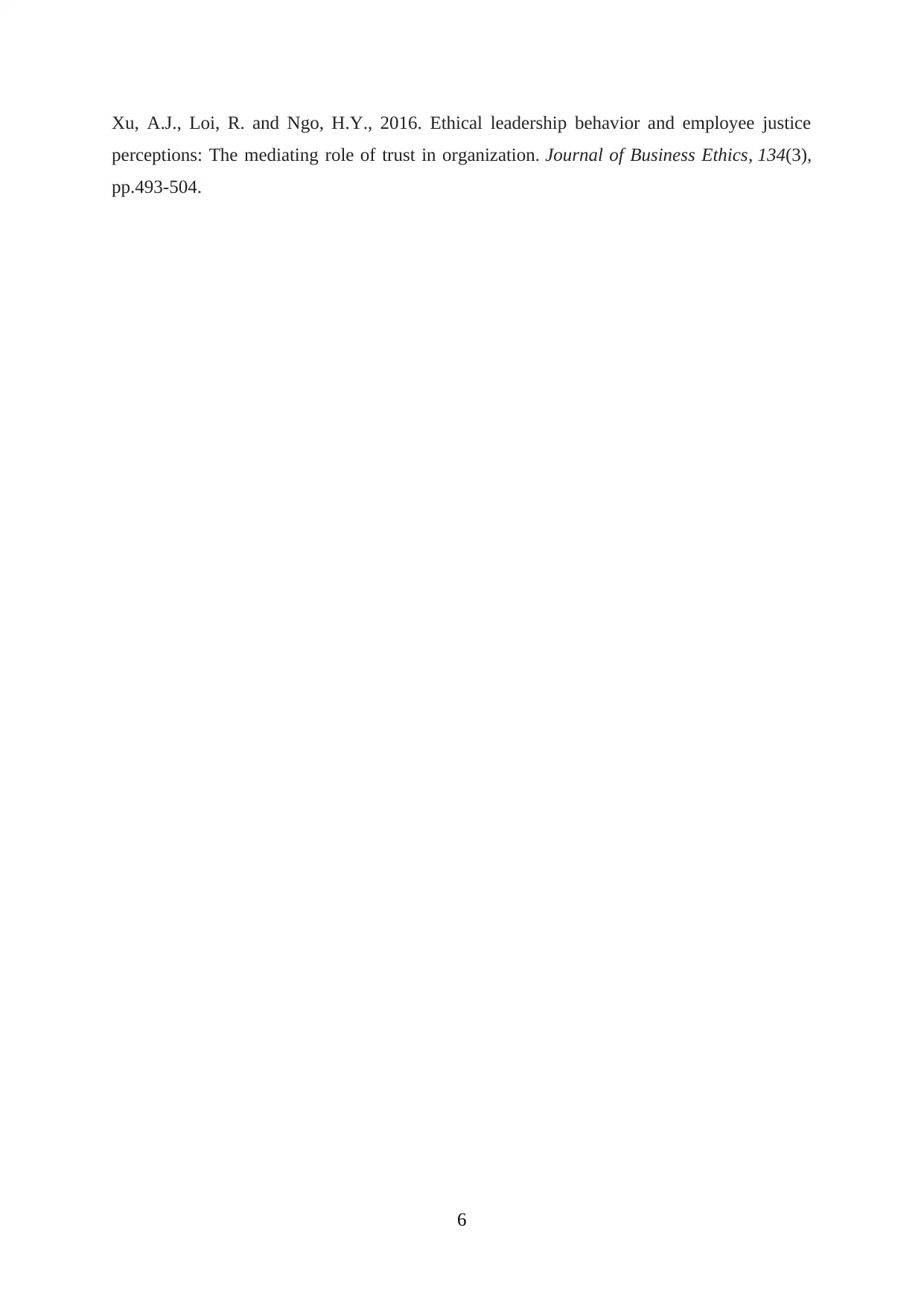Organizational Behavior: Workplace Changes, Impact and Analysis
VerifiedAdded on 2023/06/08
|7
|1564
|399
Report
AI Summary
This report examines the impact of workplace changes, specifically within GE Capital, on organizational behavior. It assesses the effects of adopting advanced technologies and cyber computing systems on managers and staff, noting both positive outcomes like improved decision-making and increased business sustainability, and negative consequences such as employee turnover and adaptation challenges. The analysis incorporates organizational behavior theories like Maslow's hierarchy to predict future impacts, emphasizing the importance of aligning employee interests with business growth. The report concludes that while organizational change is inevitable, effective management requires a nexus between organizational developments and employee growth to ensure long-term sustainability.

Organizational behaviour
Workplace changes and impact on the Organizational behavior
Organizational Behavior
Name of the Author-
University Name-
Workplace changes and impact on the Organizational behavior
Organizational Behavior
Name of the Author-
University Name-
Paraphrase This Document
Need a fresh take? Get an instant paraphrase of this document with our AI Paraphraser

Introduction
With the ramified organizational changes, organizational behaviour theories and
practices have been gaining momentum throughout the time. It is analyzed that organization
is accompanied with the number of set of activities in which various functions are undertaken
to accomplish goals and objectives. The technologies development and economic changes are
the two main factors which have influenced the organizations to change their structure,
adoption of new policies and technologies in its value chain activities to strengthen the
overall outcomes of the process. In this report, issues faced by employees, required business
changes and impact of the advancement in technologies and economic factors have been
assessed by using the organizational behaviour theories and practices.
1
With the ramified organizational changes, organizational behaviour theories and
practices have been gaining momentum throughout the time. It is analyzed that organization
is accompanied with the number of set of activities in which various functions are undertaken
to accomplish goals and objectives. The technologies development and economic changes are
the two main factors which have influenced the organizations to change their structure,
adoption of new policies and technologies in its value chain activities to strengthen the
overall outcomes of the process. In this report, issues faced by employees, required business
changes and impact of the advancement in technologies and economic factors have been
assessed by using the organizational behaviour theories and practices.
1

Changes occurred in business
Organization behaviour could be defined as study of human behaviour and how
employee will react on the basis of the undertaken decisions by the organization (Huff, et al.
2016). There are several changes are adopted by organization to compete with the changing
ramified business environment and give competition to rivals in market. In this report,
changes adopted by the GE capital Company has been assessed to determine the impact of
the changes on the individuals and how it has impacted the business growth in long run. The
management and directors have adopted the advance technologies and cyber computing
system in its process to make its business more customized and automated for mitigating the
manual process issues (Waller, and Papi, 2017).
Impact on the managers and staff members
This change was required to make the effective use of the resources and customize the
business process more clients’ oriented. It has been assessed that company strengthens the
overall outcomes and efficiency of the business by installing new machines and technologies
in its process. This change not only impacted the managers and staff members but also
requires company to change policies and business process system. However, by using the
advance cyber system and big data process in its process, managers were tending to make
more effective decisions (Schoorman, Mayer, and Davis, 2016). However, they had to take
rigours training program in working hours which consumes their lot of time but eventually it
helped them to analytical asses the available imperative information which strengthen the
overall business decision outcomes in determined approach. On the other hand, staff
members faced the process functioning issues while adapting towards the newly installed
advance cyber system and big data process. It also resulted to increased overall employee
turnover and cost of the process production system for the initial time (Quested, et al. 2017).
Prediction to determine what will happen in company after adapting
towards changes in relation to organization behaviour.
Company also had to arrange the proper training and development department for employees,
staff members and managers to adapt with the installed advance technologies. Nonetheless, it
2
Organization behaviour could be defined as study of human behaviour and how
employee will react on the basis of the undertaken decisions by the organization (Huff, et al.
2016). There are several changes are adopted by organization to compete with the changing
ramified business environment and give competition to rivals in market. In this report,
changes adopted by the GE capital Company has been assessed to determine the impact of
the changes on the individuals and how it has impacted the business growth in long run. The
management and directors have adopted the advance technologies and cyber computing
system in its process to make its business more customized and automated for mitigating the
manual process issues (Waller, and Papi, 2017).
Impact on the managers and staff members
This change was required to make the effective use of the resources and customize the
business process more clients’ oriented. It has been assessed that company strengthens the
overall outcomes and efficiency of the business by installing new machines and technologies
in its process. This change not only impacted the managers and staff members but also
requires company to change policies and business process system. However, by using the
advance cyber system and big data process in its process, managers were tending to make
more effective decisions (Schoorman, Mayer, and Davis, 2016). However, they had to take
rigours training program in working hours which consumes their lot of time but eventually it
helped them to analytical asses the available imperative information which strengthen the
overall business decision outcomes in determined approach. On the other hand, staff
members faced the process functioning issues while adapting towards the newly installed
advance cyber system and big data process. It also resulted to increased overall employee
turnover and cost of the process production system for the initial time (Quested, et al. 2017).
Prediction to determine what will happen in company after adapting
towards changes in relation to organization behaviour.
Company also had to arrange the proper training and development department for employees,
staff members and managers to adapt with the installed advance technologies. Nonetheless, it
2
⊘ This is a preview!⊘
Do you want full access?
Subscribe today to unlock all pages.

Trusted by 1+ million students worldwide

is predicted that those employees and staff members who fails to adapt with this newly
developed advance cyber system and big data process will have to leave the organization
(Rupp, Wright, Aryee, and Luo, 2015). This will also assists in solving the complicated
problems and issues in systematic work approach. After analysing the changes adopted by
the GE capital it could be assessed that with in next 10 to 12 years company will have several
positive and negative impacts on its business. The main positive impact of this change would
be related to increased business sustainability and creation of the core competency in market
to GE Capital. The proper training and development program will also strengthen the job
satisfaction for its newly hired expert employees. It will allow company to create core
competency in the advancement in technologies to compete with its rivals (Walumbwa,
Hartnell, and Misati, 2017). Company could also keep the consistent record of the job
performance of employees to reward its employees for their job motivation. It will assist
company to implement the Maslow hierarchy theory to motivate employees by satisfying
their needs and demand in long run. Nonetheless, in future, company will have low cost of
production, automation in its process and increased business outcomes which will strengthen
the brand image and overall sustainability of company in long run (Gelfand, Aycan, Erez, and
Leung, 2017). However, the main loss which company will have to bear would be loss of its
experienced employees. It is analyzed that due to the adaption towards the new policies and
technologies, experienced employees might face issue with their jobs to sustain in long run.
Apart from that, company also have to strengthen its IT expert members by hiring more
employees which could assist it to sustain its business process (Cropanzano, and Ambrose,
2015). Company has also improved its business decision making process by improving its
performance measurement by using the big data method. It has allowed company to avoid the
possible losses and issues in its business process system in effective manner. These
organizational behaviour theories could be positively influenced by managers if they interlink
the interest of the employees with the business development and growth (Xu, Loi, and Ngo,
2016). However, organization by using the proper organization behaviour theories and
practices could easily motivate employees and other staff members to adapt with the changes
in business process (Deci, Olafsen, and Ryan, 2017).
Conclusion
There are several factors which might have been affecting the business outcomes and
efficient business functioning. It is analyzed that job satisfaction, motivation and business
3
developed advance cyber system and big data process will have to leave the organization
(Rupp, Wright, Aryee, and Luo, 2015). This will also assists in solving the complicated
problems and issues in systematic work approach. After analysing the changes adopted by
the GE capital it could be assessed that with in next 10 to 12 years company will have several
positive and negative impacts on its business. The main positive impact of this change would
be related to increased business sustainability and creation of the core competency in market
to GE Capital. The proper training and development program will also strengthen the job
satisfaction for its newly hired expert employees. It will allow company to create core
competency in the advancement in technologies to compete with its rivals (Walumbwa,
Hartnell, and Misati, 2017). Company could also keep the consistent record of the job
performance of employees to reward its employees for their job motivation. It will assist
company to implement the Maslow hierarchy theory to motivate employees by satisfying
their needs and demand in long run. Nonetheless, in future, company will have low cost of
production, automation in its process and increased business outcomes which will strengthen
the brand image and overall sustainability of company in long run (Gelfand, Aycan, Erez, and
Leung, 2017). However, the main loss which company will have to bear would be loss of its
experienced employees. It is analyzed that due to the adaption towards the new policies and
technologies, experienced employees might face issue with their jobs to sustain in long run.
Apart from that, company also have to strengthen its IT expert members by hiring more
employees which could assist it to sustain its business process (Cropanzano, and Ambrose,
2015). Company has also improved its business decision making process by improving its
performance measurement by using the big data method. It has allowed company to avoid the
possible losses and issues in its business process system in effective manner. These
organizational behaviour theories could be positively influenced by managers if they interlink
the interest of the employees with the business development and growth (Xu, Loi, and Ngo,
2016). However, organization by using the proper organization behaviour theories and
practices could easily motivate employees and other staff members to adapt with the changes
in business process (Deci, Olafsen, and Ryan, 2017).
Conclusion
There are several factors which might have been affecting the business outcomes and
efficient business functioning. It is analyzed that job satisfaction, motivation and business
3
Paraphrase This Document
Need a fresh take? Get an instant paraphrase of this document with our AI Paraphraser

decision making process are some of the aspects which highly influenced by the undertaken
new process system. After analysing, it could be inferred that change in organization is
inevitable and managers and directors needs to establish the linkage or nexus between the
Organizaiton developments with the employee’s growth to keep the basins more sustainable
in long run. The curx of this assignment is that the adopted change not only impacted the
managers and staff members but also requires company to change policies and business
process system, code of conduct and organizational culture of business in long run.
4
new process system. After analysing, it could be inferred that change in organization is
inevitable and managers and directors needs to establish the linkage or nexus between the
Organizaiton developments with the employee’s growth to keep the basins more sustainable
in long run. The curx of this assignment is that the adopted change not only impacted the
managers and staff members but also requires company to change policies and business
process system, code of conduct and organizational culture of business in long run.
4

References
Cropanzano, R.C. and Ambrose, M.L., 2015. Organizational justice: Where we have been
and where we are going. The Oxford handbook of justice in the workplace, pp.3-14.
Deci, E.L., Olafsen, A.H. and Ryan, R.M., 2017. Self-determination theory in work
organizations: the state of a science. Annual Review of Organizational Psychology and
Organizational Behavior, 4, pp.19-43.
Gelfand, M.J., Aycan, Z., Erez, M. and Leung, K., 2017. Cross-cultural industrial
organizational psychology and organizational behavior: A hundred-year journey. Journal of
Applied Psychology, 102(3), p.514.
Huff, A.S., Milliken, F.J., Hodgkinson, G.P., Galavan, R.J. and Sund, K.J., 2016. A
conversation on uncertainty in managerial and organizational cognition. In Uncertainty and
strategic decision making 102(3), p,1-31. Emerald Group Publishing Limited.
Quested, E., Ntoumanis, N., Thøgersen-Ntoumani, C., Hagger, M.S. and Hancox, J.E., 2017.
Evaluating quality of implementation in physical activity interventions based on theories of
motivation: current challenges and future directions. International Review of Sport and
Exercise Psychology, 10(1), pp.252-269.
Rupp, D.E., Wright, P.M., Aryee, S. and Luo, Y., 2015. Organizational justice, behavioral
ethics, and corporate social responsibility: Finally the three shall merge. Management and
Organization Review, 11(1), pp.15-24.
Schoorman, F.D., Mayer, R.C. and Davis, J.H., 2016. Perspective: Empowerment in
veterinary clinics: the role of trust in delegation. Journal of Trust Research, 6(1), pp.91-95.
Waller, L. and Papi, M., 2017. Motivation and feedback: How implicit theories of
intelligence predict L2 writers’ motivation and feedback orientation. Journal of Second
Language Writing, 35, pp.54-65.
Walumbwa, F.O., Hartnell, C.A. and Misati, E., 2017. Does ethical leadership enhance group
learning behavior? Examining the mediating influence of group ethical conduct, justice
climate, and peer justice. Journal of Business Research, 72, pp.14-23.
5
Cropanzano, R.C. and Ambrose, M.L., 2015. Organizational justice: Where we have been
and where we are going. The Oxford handbook of justice in the workplace, pp.3-14.
Deci, E.L., Olafsen, A.H. and Ryan, R.M., 2017. Self-determination theory in work
organizations: the state of a science. Annual Review of Organizational Psychology and
Organizational Behavior, 4, pp.19-43.
Gelfand, M.J., Aycan, Z., Erez, M. and Leung, K., 2017. Cross-cultural industrial
organizational psychology and organizational behavior: A hundred-year journey. Journal of
Applied Psychology, 102(3), p.514.
Huff, A.S., Milliken, F.J., Hodgkinson, G.P., Galavan, R.J. and Sund, K.J., 2016. A
conversation on uncertainty in managerial and organizational cognition. In Uncertainty and
strategic decision making 102(3), p,1-31. Emerald Group Publishing Limited.
Quested, E., Ntoumanis, N., Thøgersen-Ntoumani, C., Hagger, M.S. and Hancox, J.E., 2017.
Evaluating quality of implementation in physical activity interventions based on theories of
motivation: current challenges and future directions. International Review of Sport and
Exercise Psychology, 10(1), pp.252-269.
Rupp, D.E., Wright, P.M., Aryee, S. and Luo, Y., 2015. Organizational justice, behavioral
ethics, and corporate social responsibility: Finally the three shall merge. Management and
Organization Review, 11(1), pp.15-24.
Schoorman, F.D., Mayer, R.C. and Davis, J.H., 2016. Perspective: Empowerment in
veterinary clinics: the role of trust in delegation. Journal of Trust Research, 6(1), pp.91-95.
Waller, L. and Papi, M., 2017. Motivation and feedback: How implicit theories of
intelligence predict L2 writers’ motivation and feedback orientation. Journal of Second
Language Writing, 35, pp.54-65.
Walumbwa, F.O., Hartnell, C.A. and Misati, E., 2017. Does ethical leadership enhance group
learning behavior? Examining the mediating influence of group ethical conduct, justice
climate, and peer justice. Journal of Business Research, 72, pp.14-23.
5
⊘ This is a preview!⊘
Do you want full access?
Subscribe today to unlock all pages.

Trusted by 1+ million students worldwide

Xu, A.J., Loi, R. and Ngo, H.Y., 2016. Ethical leadership behavior and employee justice
perceptions: The mediating role of trust in organization. Journal of Business Ethics, 134(3),
pp.493-504.
6
perceptions: The mediating role of trust in organization. Journal of Business Ethics, 134(3),
pp.493-504.
6
1 out of 7
Related Documents
Your All-in-One AI-Powered Toolkit for Academic Success.
+13062052269
info@desklib.com
Available 24*7 on WhatsApp / Email
![[object Object]](/_next/static/media/star-bottom.7253800d.svg)
Unlock your academic potential
Copyright © 2020–2026 A2Z Services. All Rights Reserved. Developed and managed by ZUCOL.





